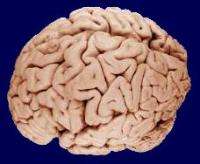Research discovers how brain activity changes when anesthesia induces unconsciousness

Investigators at Massachusetts General Hospital (MGH) and Massachusetts Institute of Technology (MIT) have identified for the first time a pattern of brain activity that appears to signal exactly when patients lose consciousness under general anesthesia. Although their study only involved use of one anesthetic drug, propofol, the researchers believe that their findings will apply to other forms of general anesthesia and could lead to better ways of monitoring anesthetized patients.
"How anesthetics produce unconsciousness is a major scientific mystery, so this finding is very important because it suggests a specific mechanism for how propofol, one of the most widely used anesthetic drugs, works," says Patrick Purdon, PhD, senior author of the report appearing in PNAS Plus. "The pattern that we found marks a new brain state in which neurons in different areas become inactivated at different times, impairing communication between different brain regions." Purdon is an Instructor in Anesthesia in the MGH Department of Anesthesia, Critical Care and Pain Medicine at Harvard Medical School.
The current hypothesis on the nature of unconsciousness is that it represents a loss of communication functions throughout the brain. Animal studies of the effects of general anesthesia cannot accurately determine when consciousness is lost. The current study measured the activity of both single neurons and neuronal networks in three patients who previously had electrodes implanted into their brain to help diagnose epilepsy. At the outset of surgical procedures to remove the electrodes, patients were asked to press a button whenever they heard a tone, which was generated every four seconds. When a patient failed to respond to two tones in a row, the five-second period defined by those tones was identified as the point when consciousness was lost.
Measurement of the activity of single neurons showed a drop in overall activity but not until up to 30 seconds after consciousness had been lost. But the time when consciousness was lost did coincide with a significant change in the overall structure of brain activity. While electrical activity in the conscious brain appears to be disorganized with no apparent regular patterns, at the point when study participants lost consciousness, their brain activity began to show regular oscillations between states of activation and deactivation.
"These deactivated or silent periods of brain activity occur at different times in different brain regions, so communication between regions is interrupted" says Laura Lewis, co-lead author of the report. "It's as if one brain region is in Boston and the other is in Singapore – they can't make phone calls to each other because one is asleep when the other is awake." While this slow oscillation pattern has been previously observed in humans who are asleep or under ansethesia, this is the first study to record neuronal activity during the transition to unconsciousness, so it is the first to match the onset of this pattern with the loss of consciousness, she adds. Lewis is a graduate student in the MIT Department of Brain and Cognitive Sciences, working with Purdon and with Emery Brown, MD, PhD, the Warren M. Zapol Professor of Anaesthesia at MGH and Harvard Medical School and professor in the MIT Department of Brain and Cognitive Sciences.
Purdon explains, "Previously, the brain wave patterns and brain physiology indicating unconsciousness were not clear, so anesthesiologists did not have a principled way to monitor the brain during general anesthesia. Without this knowledge, existing anesthetic brain monitors are highly inaccurate. Now that we have identified a specific physiological marker associated with unconsciousness, we can develop systems that accurately indicate patients' level of consciousness and help anesthesiologists determine the best drug dosage to use. Having that information could both prevent the rare instances when patients regain consciousness during surgery and avoid anesthesia overdoses."
More information: "Rapid fragmentation of neuronal networks at the onset of propofol-induced unconsciousness," by Laura D. Lewis et al. www.pnas.org/content/early/201 … /1210907109.abstract
















